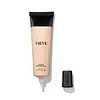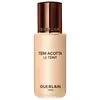What's inside
What's inside
 Key Ingredients
Key Ingredients

 Benefits
Benefits

 Concerns
Concerns

 Ingredients Side-by-side
Ingredients Side-by-side

Water
Skin ConditioningOctyldodecanol
EmollientHexyl Laurate
EmollientC9-12 Alkane
SolventPolyglyceryl-6 Polyricinoleate
EmulsifyingPropanediol
SolventMica
Cosmetic ColorantPolyglyceryl-3 Diisostearate
EmulsifyingDisteardimonium Hectorite
StabilisingNiacinamide
SmoothingMagnesium Sulfate
Caprylyl Glycol
Emollient1,2-Hexanediol
Skin ConditioningMagnesium Stearate
Cosmetic ColorantSodium Dehydroacetate
PreservativeGlycerin
HumectantCoco-Caprylate/Caprate
EmollientParfum
MaskingAluminum Hydroxide
EmollientSodium Lauroyl Glutamate
Collagen Amino Acids
MoisturisingPentylene Glycol
Skin ConditioningLysine
Skin ConditioningLeuconostoc/Radish Root Ferment Filtrate
AntimicrobialMagnesium Chloride
Polyglutamic Acid
Skin ConditioningAlgin
MaskingGlyceryl Polyacrylate
Sodium Hyaluronate
HumectantPullulan
Haberlea Rhodopensis Leaf Extract
Skin ConditioningAphanothece Sacrum Polysaccharide
AbsorbentLimonene
PerfumingBenzyl Salicylate
PerfumingLinalool
PerfumingCitronellol
PerfumingCitral
PerfumingCI 77891
Cosmetic ColorantIron Oxides
CI 77491
Cosmetic ColorantCI 77947
CI 77499
Cosmetic ColorantWater, Octyldodecanol, Hexyl Laurate, C9-12 Alkane, Polyglyceryl-6 Polyricinoleate, Propanediol, Mica, Polyglyceryl-3 Diisostearate, Disteardimonium Hectorite, Niacinamide, Magnesium Sulfate, Caprylyl Glycol, 1,2-Hexanediol, Magnesium Stearate, Sodium Dehydroacetate, Glycerin, Coco-Caprylate/Caprate, Parfum, Aluminum Hydroxide, Sodium Lauroyl Glutamate, Collagen Amino Acids, Pentylene Glycol, Lysine, Leuconostoc/Radish Root Ferment Filtrate, Magnesium Chloride, Polyglutamic Acid, Algin, Glyceryl Polyacrylate, Sodium Hyaluronate, Pullulan, Haberlea Rhodopensis Leaf Extract, Aphanothece Sacrum Polysaccharide, Limonene, Benzyl Salicylate, Linalool, Citronellol, Citral, CI 77891, Iron Oxides, CI 77491, CI 77947, CI 77499
Water
Skin ConditioningC9-12 Alkane
SolventAlcohol
AntimicrobialUndecane
EmollientSilica
AbrasivePropanediol
SolventPolyglyceryl-2 Dipolyhydroxystearate
Skin ConditioningGlycerin
HumectantTridecane
PerfumingDisteardimonium Hectorite
StabilisingCoco-Caprylate/Caprate
EmollientDicaprylyl Ether
EmollientPolyglyceryl-3 Diisostearate
EmulsifyingTrimethylsiloxysilicate
EmollientCI 77120
Cosmetic ColorantVinyl Dimethicone/Lauryl Dimethicone Crosspolymer
Brassica Campestris Seed Oil
Skin ConditioningSodium Myristoyl Glutamate
CleansingPropylene Carbonate
SolventParfum
MaskingLecithin
EmollientCaprylic/Capric Triglyceride
MaskingOpuntia Ficus-Indica Flower Extract
Skin ConditioningPolyhydroxystearic Acid
EmulsifyingSodium Benzoate
MaskingSodium Citrate
BufferingCamelina Sativa Seed Oil
Skin ConditioningAluminum Hydroxide
EmollientCitric Acid
BufferingIsostearic Acid
CleansingPolyglyceryl-3 Polyricinoleate
EmulsifyingMica
Cosmetic ColorantArgania Spinosa Kernel Oil
EmollientPalmitic Acid
EmollientTocopherol
AntioxidantMagnesium Hydroxide
AbsorbentCI 77891
Cosmetic ColorantCI 77491
Cosmetic ColorantCI 77492
Cosmetic ColorantCI 77499
Cosmetic ColorantCI 77163
Cosmetic ColorantWater, C9-12 Alkane, Alcohol, Undecane, Silica, Propanediol, Polyglyceryl-2 Dipolyhydroxystearate, Glycerin, Tridecane, Disteardimonium Hectorite, Coco-Caprylate/Caprate, Dicaprylyl Ether, Polyglyceryl-3 Diisostearate, Trimethylsiloxysilicate, CI 77120, Vinyl Dimethicone/Lauryl Dimethicone Crosspolymer, Brassica Campestris Seed Oil, Sodium Myristoyl Glutamate, Propylene Carbonate, Parfum, Lecithin, Caprylic/Capric Triglyceride, Opuntia Ficus-Indica Flower Extract, Polyhydroxystearic Acid, Sodium Benzoate, Sodium Citrate, Camelina Sativa Seed Oil, Aluminum Hydroxide, Citric Acid, Isostearic Acid, Polyglyceryl-3 Polyricinoleate, Mica, Argania Spinosa Kernel Oil, Palmitic Acid, Tocopherol, Magnesium Hydroxide, CI 77891, CI 77491, CI 77492, CI 77499, CI 77163
Ingredients Explained
These ingredients are found in both products.
Ingredients higher up in an ingredient list are typically present in a larger amount.
Aluminum Hydroxide is a form of aluminum. It can be naturally found in nature as the mineral gibbsite. In cosmetics, Aluminum Hydroxide is used as a colorant, pH adjuster, and absorbent.
As a colorant, Aluminum Hydroxide may add opacity, or reduce the transparency. Aluminum hydroxide is contains both basic and acidic properties.
According to manufacturers, this ingredient is an emollient and humectant. This means it helps hydrate the skin.
In medicine, this ingredient is used to help relieve heartburn and help heal ulcers.
There is currently no credible scientific evidence linking aluminum hydroxide in cosmetics to increased cancer risk.
Major health organizations allow the use of aluminum hydroxide in personal care products and have not flagged it as a carcinogenic risk at typical usage levels.
Learn more about Aluminum HydroxideC9-12 Alkane is synethically created using alkanes, or paraffins. It is added to products as a solvent. This means its main purpose is to help dissolve ingredients and create even texture.
Ci 77491 is also hydrated iron III oxide. It's sole purpose is to give a red/pink hue to products.
Iron III oxides are classified as inorganic chemicals for coloring.
Synthetically created Ci 77491 is considered safer than those naturally found. This is because the synthetically created version may contain less impurities. Iron oxides are generally non-toxic and non-allergenic.
Learn more about CI 77491Ci 77499 is also hydrated iron III oxide. It is created from mixing red and black iron oxides. This helps give shades of darkness to a product.
Iron III oxides are classified as inorganic chemicals for coloring.
Ci 77891 is a white pigment from Titanium dioxide. It is naturally found in minerals such as rutile and ilmenite.
It's main function is to add a white color to cosmetics. It can also be mixed with other colors to create different shades.
Ci 77891 is commonly found in sunscreens due to its ability to block UV rays.
Learn more about CI 77891Coco-Caprylate/Caprate is created from fatty coconut alcohol, caprylic acid, and capric acid.
It is a lightweight emollient. Emollients create a thin barrier on the skin to trap moisture in. This helps keep your skin hydrated and soft.
Once applied, Coco-Caprylate/Caprate is absorbed quickly and leaves a silky feel.
Coco-Caprylate/Caprate may not be fungal acne safe.
Learn more about Coco-Caprylate/CaprateDisteardimonium Hectorite comes from the clay mineral named hectorite. It is used to add thickness to a product.
It can also help stabilize a product by helping to disperse other ingredients.
Hectorite is a rare, white clay mineral.
Learn more about Disteardimonium HectoriteGlycerin is already naturally found in your skin. It helps moisturize and protect your skin.
A study from 2016 found glycerin to be more effective as a humectant than AHAs and hyaluronic acid.
As a humectant, it helps the skin stay hydrated by pulling moisture to your skin. The low molecular weight of glycerin allows it to pull moisture into the deeper layers of your skin.
Hydrated skin improves your skin barrier; Your skin barrier helps protect against irritants and bacteria.
Glycerin has also been found to have antimicrobial and antiviral properties. Due to these properties, glycerin is often used in wound and burn treatments.
In cosmetics, glycerin is usually derived from plants such as soybean or palm. However, it can also be sourced from animals, such as tallow or animal fat.
This ingredient is organic, colorless, odorless, and non-toxic.
Glycerin is the name for this ingredient in American English. British English uses Glycerol/Glycerine.
Learn more about GlycerinMica is a naturally occurring mineral used to add shimmer and color in cosmetics. It can also help improve the texture of a product or give it an opaque, white/silver color.
Serecite is the name for very fine but ragged grains of mica.
This ingredient is often coated with metal oxides like titanium dioxide. Trace amounts of heavy metals may be found in mica, but these metals are not harmful in our personal products.
Mica has been used since prehistoric times throughout the world. Ancient Egyptian, Indian, Greek, Roman, Aztec, and Chinese civilizations have used mica.
Learn more about MicaParfum is a catch-all term for an ingredient or more that is used to give a scent to products.
Also called "fragrance", this ingredient can be a blend of hundreds of chemicals or plant oils. This means every product with "fragrance" or "parfum" in the ingredients list is a different mixture.
For instance, Habanolide is a proprietary trade name for a specific aroma chemical. When used as a fragrance ingredient in cosmetics, most aroma chemicals fall under the broad labeling category of “FRAGRANCE” or “PARFUM” according to EU and US regulations.
The term 'parfum' or 'fragrance' is not regulated in many countries. In many cases, it is up to the brand to define this term.
For instance, many brands choose to label themselves as "fragrance-free" because they are not using synthetic fragrances. However, their products may still contain ingredients such as essential oils that are considered a fragrance by INCI standards.
One example is Calendula flower extract. Calendula is an essential oil that still imparts a scent or 'fragrance'.
Depending on the blend, the ingredients in the mixture can cause allergies and sensitivities on the skin. Some ingredients that are known EU allergens include linalool and citronellol.
Parfum can also be used to mask or cover an unpleasant scent.
The bottom line is: not all fragrances/parfum/ingredients are created equally. If you are worried about fragrances, we recommend taking a closer look at an ingredient. And of course, we always recommend speaking with a professional.
Learn more about ParfumPolyglyceryl-3 Diisostearate is an emulsifer and emollient. It comes from Isostearic Acid and Polyglycerin-3.
As an emulsifier, it helps stabilize products by preventing oils and water from separating.
This ingredient may not be Malassezia folliculitis, or fungal acne safe.
Learn more about Polyglyceryl-3 DiisostearatePropanediol is an all-star ingredient. It softens, hydrates, and smooths the skin.
It’s often used to:
Propanediol is not likely to cause sensitivity and considered safe to use. It is derived from corn or petroleum with a clear color and no scent.
Learn more about PropanediolWater. It's the most common cosmetic ingredient of all. You'll usually see it at the top of ingredient lists, meaning that it makes up the largest part of the product.
So why is it so popular? Water most often acts as a solvent - this means that it helps dissolve other ingredients into the formulation.
You'll also recognize water as that liquid we all need to stay alive. If you see this, drink a glass of water. Stay hydrated!
Learn more about Water